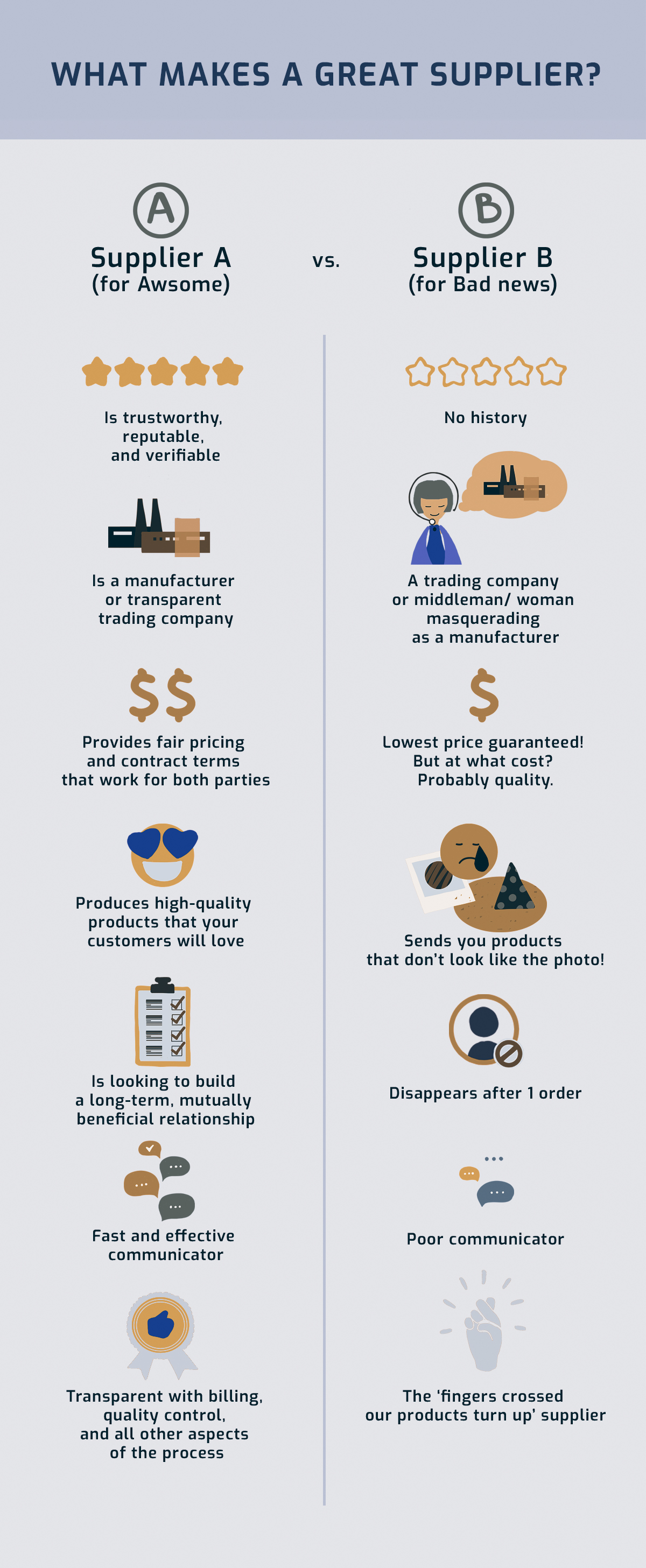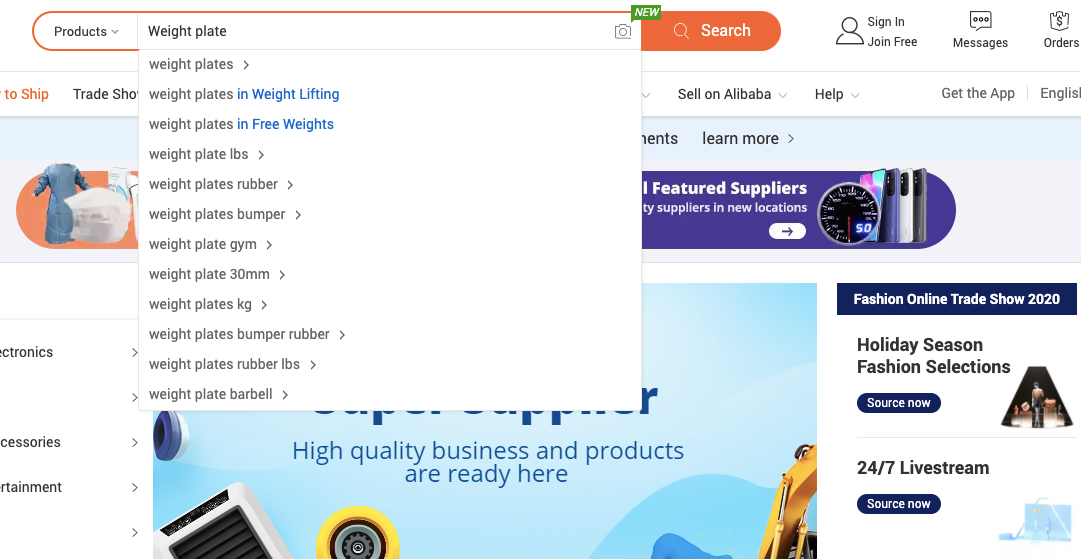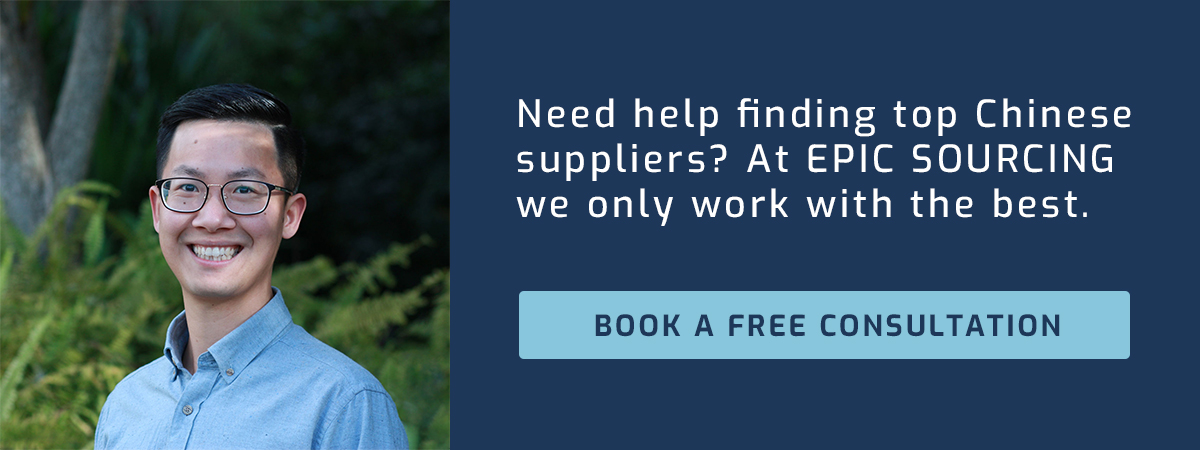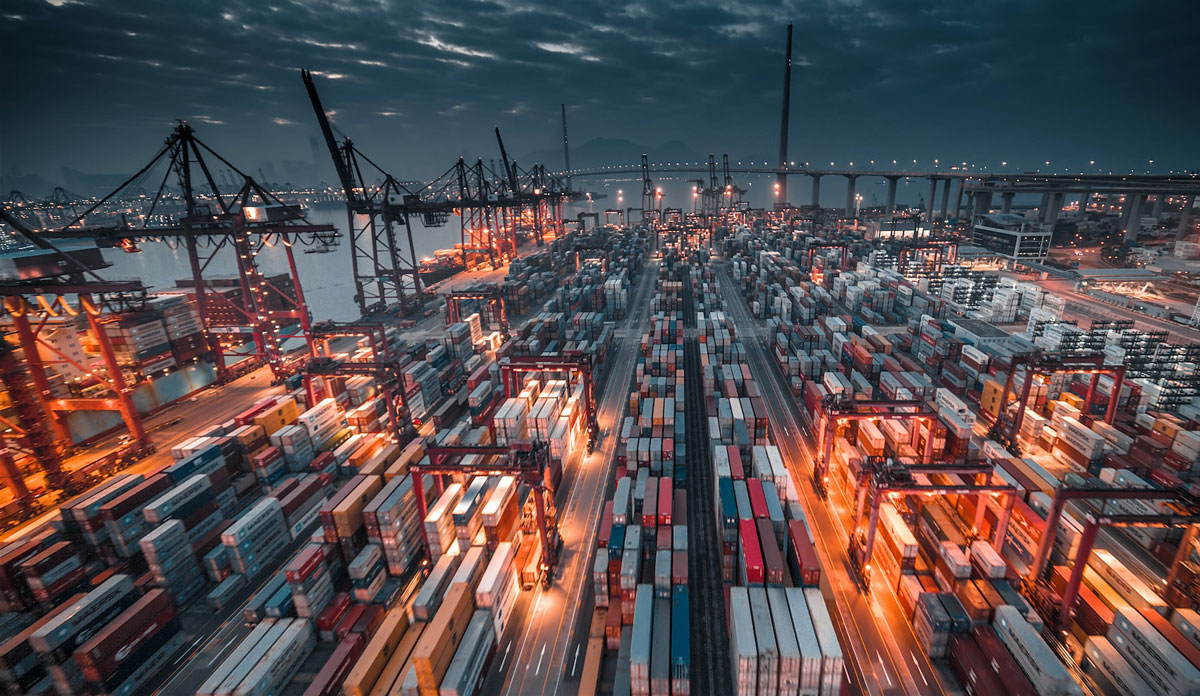
How to find the best Alibaba legitimate and verified suppliers
Greetings eCommerce up-and-comers!
In this section of the blog we talk about how to source products like a pro. It’s never been a better time to start selling products online and we’re here to share our knowledge. Today’s topic is how to find the best suppliers on Alibaba.
As a sourcing agent for small businesses, one of the biggest queries I get is about how to find the right supplier in China. The rise of B2B sites like Alibaba and Global Sources has made it easier than ever to connect with suppliers and manufacturers, but having a nearly infinite number of options can make the process a daunting one.
Supplier prospecting is one of the most important steps in the sourcing process, but one that many businesses rush through as they excitedly move towards getting their product to market. Getting this step right will save you A LOT of time, money, and hassle further down the track.
So, in this post we’ll show you how to find the best suppliers on Alibaba for your online business. It will help you weed out the time-wasters, the middlemen, and mischief-makers, so you can source with confidence.

Step 1. Where to start looking - The B2B marketplace
There are 3 main options when it comes to initiating your search for a Chinese supplier. For the purposes of this post, we’ll focus on Alibaba, but it’s worth noting that you have other options.
- B2B marketplace
- Trade fair
- Sourcing agent/ agency
The B2B marketplace
Unless you’ve been living under a rock, you’ve probably heard of Alibaba. For the novice, Alibaba is an excellent place to start. As it’s the largest and most well-established B2B marketplace, it’s a straightforward place to start your search. Many people argue that there is a lot of ‘noise’ to wade through on Alibaba, and Global Sources is a better option in that respect. We would agree, but for the beginner, Alibaba is simple to use, with more products on offer, and quite often lower MOQs.
The Trade Fair
As they say, nothing beats being there. Visiting a trade fair like The Canton Fair in Guangzhou can be an eye-opening experience for an eCommerce business owner. Not only does it allow you to connect with suppliers face to face, but it’s a fantastic way to find new products and see what’s coming through the pipeline in your particular niche. Alas, 2020 has made visiting a trade fair rather difficult - so this option might be ‘on-hold’ for many. Fingers crossed for 2021.
The Sourcing Agent
The 3rd option is to essentially outsource the prospecting phase. A sourcing agent worth their salt will be able to connect you with top suppliers and essentially guide you through the process so you don’t have to do the research and due diligence. We won’t go into too much detail on whether or not a sourcing agent is the right option for you, but if you want to read more on the topic, check out this blog post.
Step 2: Define your requirements
Come prepared. As we’ll see later in the process, it pays to be prepared with as much information as possible before you start reaching out to suppliers or manufacturers.
Your product
Understand the product you want to source. Know the dimensions, the weight, its functionality, and what materials it’s made of. Knowing this will show potential suppliers that a) you are serious, and b) you know what you want and they can’t pull the wool over your eyes. Communication is key, so you need to be very clear about what you need.
Know your numbers
Having some key numbers on hand will help you determine whether or not a supplier is right for you. If you’re trying to make money (that would be nice), then you need to know your margins. Have an idea of the following:
- Your price point
- Your max cost per unit
- The number of units you need
- A shipping estimate (if possible)
- Add ons - packaging/ logo (you might not be able to estimate these costs, but it’s helpful to allow space for them)
- Duty costs. If you’re importing into New Zealand, visit the customs website to estimate the duty you will have to pay.
These numbers will almost certainly change as you move through the process, but it helps establish solid ballpark figures to work with.
Are you manufacturing or white labeling?
Are you creating a bespoke, original product from scratch, or are you looking to source a product that already exists?
Manufacturing a product from scratch is going to be a more expensive and time-consuming process. While this is perfectly doable, if you’re just starting out, you might be able to dip your toes with a white label product that fits within your product line. This is also a great way to fill out your product line over time. Many eCommerce entrepreneurs have a flagship product designed from scratch and then add white label products to sell as supplementary offerings.
FAQ: What is a White Label product?
Many people think that if you want to start selling a branded product, you need to invent it. Not so! There are millions of products you can buy from suppliers in China, rebrand with your own logo, and sell online to your target market. For this reason, it pays to research the product you want to sell, as it may already exist. Your margin won’t be as big if you’re white labeling, but neither will the bill to source it.
Step 3: Find a supplier that understands your industry
China.Is.BIG. In fact, from a sourcing perspective, it makes more sense to look at it as multiple, specialised regions, rather than 1 homogenous zone. It’s true that you can get consumer electronics from a number of regions in China, but it pays to start looking in the region that specialises in this category of products; Guangdong. Need fireworks? Well, you should probably start in Hunan Province.
Finding a supplier or manufacturer that specialises in the products you are looking to import is a great start. They will have plenty of experience dealing with similar businesses, understand industry quality standards and pricing, and be quick to understand and act upon any changes you might require. They are also more likely to have stock that will enable them to fulfill orders in a timely manner.
For your reference, here is a map of the main manufacturing areas, or industrial clusters in China.
Step 4: The search - filter out the rabble on Alibaba
Armed with the above info, it’s time to start wading through your options on Alibaba.
Naturally, your search will start by entering the name of the product you’re looking for.

Be specific with the keywords you enter and narrow down the options. For example: If you’re looking to import weight plates, enter in relevant specifics like ‘Olympic’ or ‘rubber’ or ‘competition’. You’ll find every version of your product imaginable on Alibaba, so be specific.
Once you’ve done your initial search, there are some useful filters to further narrow down your options.
Trade assurance
Trade Assurance is a way to protect yourself should the supplier fail to deliver on their promises. If a supplier doesn’t ship your products, can’t deliver on time, or the quality is below what was agreed, you can make a claim. Note that you should clearly define these terms in your agreement so that in the event you need to make a claim to Alibaba, you have clear documentation to back it up.
Verified seller
A Verified Supplier has been verified by a 3rd party not affiliated with Alibaba. This covers the company profile, management system, production capabilities, and process controls.
Filter by location
As we mentioned above, it can be useful to narrow down your search to suppliers operating in the region that specialises in the products you are looking to source. This is not a must, but it’s another useful tool to weed out sub-standard suppliers.
Certification
There is also an option to filter by ISO certification. ISO9001 is an international standard that outlines adherence to a quality management system (QMS). Suppliers on Alibaba use this certification to show they can consistently provide products that meet customer and regulatory requirements.
It’s worth noting that just because a supplier hasn’t had 3rd party verification, doesn’t mean it’s fraudulent or bad. Conversely, applying these filters is not an absolute guarantee. But, if you’re tackling the sourcing process alone, you want to take steps to minimise the risk.
Shameless plug - this is one of the benefits of using a sourcing agent. Not only is it a way to ensure you’re dealing with a high-quality supplier, but it enables you to cast the net wider. As a sourcing agent, I need to be able to get my clients the best pricing and contract terms while working with top-quality suppliers. The reality is that many top suppliers don’t list on sites like Alibaba.
Now that you’ve filtered harder than Kevin Costner in Waterworld, what does a good supplier look like?

- Professional listing - their listings will be in-depth and look professional with high-quality photos.
- Clear product descriptions - products will be supported with clear descriptions with details like specs and materials.
- Videos of the product and the factory
- Details about their factory and product niche - their profile will include plenty of company information.
- Specialists - do they specialise in the type of products you want? (as opposed to a very wide variety of unrelated products)
- Commitment to some QC protocol - the company will list the industry standards they adhere to.

Step 5: Skip the middleman/ woman or trading company
B2B marketplaces are rife with middlemen/women. Before we go into ways of avoiding them, I should note that they aren’t always bad. Depending on the product you’re looking for, you might find a reseller that fits the bill perfectly.
So, how can you skip the Trading Company or middle person?
- Check the ‘Business type’ on the Alibaba listing. Trading company = middle person. Note that some will have both Trading Company and Manufacturer listed - this is generally ok. Once again, there is no absolute guarantee that this info is legitimate. Let’s just say it’s not impossible to bribe your inspector to get listed as a manufacturer.
- Visit the Chinese Business Directory. This is a pretty fail-safe way to check, but given that the website is in Chinese, for most people it’s not really an option.
- Talk to a sourcing agent. A sourcing agent can check the Chinese Business Directory for you and provide you with a detailed report on your chosen supplier.
Some other red flags
- No pics of the factory floor
- A wide array of unrelated products
Step 6: Create a prospective supplier list
Having taken the steps above, you’re ready to start building a list of prospective suppliers.
Create a spreadsheet and collect the following information before contacting suppliers:
- Name
- Location
- Whether they are a factory or a trading company
- Contact information (email)
- Minimum Order Quantity (MOQ), price, and lead time
- Website address
Ideally, you want to create a list of between 10-20 suppliers. This will give you a good overview of which suppliers are outliers in terms of price or other contract terms.
Related Articles
Let’s Make It Epic
We're here to make sourcing simple – and a whole lot less stressful.

.svg)

.svg)





